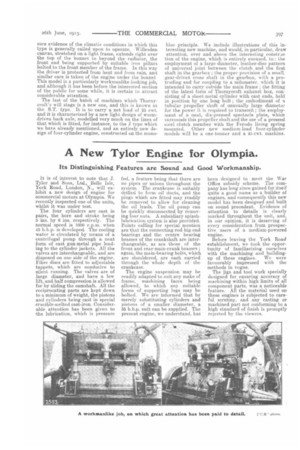A New Tylor Engine for Olympia.
Page 23

If you've noticed an error in this article please click here to report it so we can fix it.
Its Distinguishing Features are Sound and Good Workmanship.
It is of interest to note that J. Tylor and Sons, Ltd., Belle Isle, York Road, London, N., will exhibit a new design of engine for commercial motors at Olympia. We recently inspected one of the units, whilst it was under test.
The four cylinders are cast in pairs, the bore and stroke being 5 ins. by 6 ins. respectively. The normal speed is 1000 r.p.m. when 45 bhp. is developed. The cooling water is circulated by means of a centrifugal pump through a neat form of east gun-metal pipe leading to the cylinder jackets. All the valves are interchangeable, and are disposed on one side of the engine. Fibre discs are fitted to adjustable tappets, which are conducive to silent running. The valves are of large diameter, and have a low lift, and half compression is allowed for by sliding the camshaft. All the reciprocating parts are kept down to a minimum of weight, the pistons and cylinders being cast in special .crucible-rneltcd cast-iron. Considerable attention has been given to the lubrication, which is pressure fed, a feature being that there are no pipes or unions throughout the system. The crankcase is suitably drilled to form oil ducts, and the plugs which are fitted may readily be removed to allow for cleaning the oil leads. The oil pump can be quickly disconnected by removmg four nuts. A subsidiary splashlubrication system is also provided. Points calling for special mention are that the connecting-rod big-end bearings and the centre bearing brasses of the crankshaft are interchangeable, as are those of the front and rear main-crank brasses ; again, the main-bearing bolts, which are shouldered, are each carried through the whole depth of the crankcase.
The engine suspension may be readily adapted to suit any make of frame, machining faces being allowed, to which any suitable forms of supporting lugs may be bolted. We are informed that by merely substituting cylinders and pistons of a smaller diameter, a 35 b.h.p. unit can be supplied. The present engine, we understand, has been designed to meet the War Office subsidy scheme. The company has long since gained for itself quite a good name as a builder of engines, and consequently this new model has been designed and built on sound precedent. Evidence of attention to details is clearly marked throughout the unit, and, in our opinion, it is deserving of every consideration from prospective users of a medium-powered engine.
Before leaving the York Road establishment, we took the opportunity of familiarizing ourselves with the machining and buildingup of these engines. We were favourably impressed with the methods in vogue.
The jigs and tool work specially designed for ensuring accuracy of machining within high limits of all component parts, was a noticeable feature. All the material used on these engines is subjected to careful scrutiny, and any casting or machined part not conforming to a high standard of finish is promptly rejected by the viewers.
































